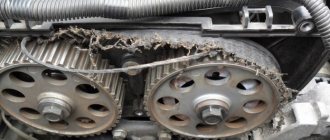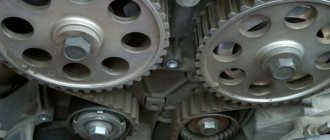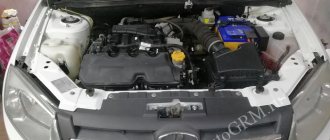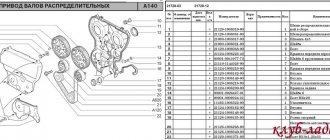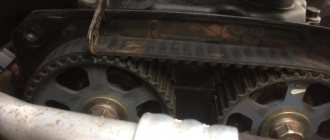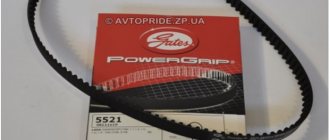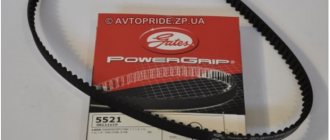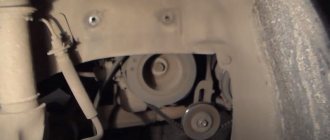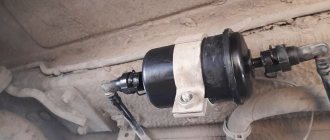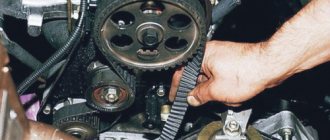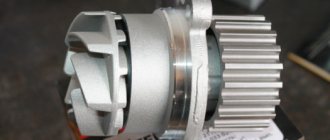Lada Priora is a Russian car that is popular among experienced motorists due to its advanced design. Good acceleration capabilities and powerful engine. Another advantage is the low cost of this vehicle. According to the car manual, we will take a step-by-step look at the timing marks (timing belt). Which is located on the engine with 16 valves.
The tension roller guides the belt
However, experts advise changing the belt after driving 50,000 - 60,000 km. It is possible to carry out such a replacement yourself, in your garage. But don't forget about the marks on the shafts. If the instructions are followed, this procedure will be quite accessible to the amateur motorist.
What is timing belt
The abbreviation GRM stands for Gas Distribution Mechanism. This mechanism distributes the air-fuel mixture among the cylinders through the valves.
The timing structure includes:
- Camshaft
- valves
- Valve adjustment washers or expansion joints
Timing belt side view
Gas distribution mechanism (GRM): 1 — timing marks on the rear cover; 2 — rear timing cover; 3 — intake camshaft gear; 4 — phase sensor ring; 5 — mark on the intake camshaft gear; 6 — exhaust camshaft gear; 7 — deflection roller; 8 — tension roller; 9 — timing belt; 10 — coolant pump; 11 — mark on the oil pump body; 12 — mark on the crankshaft gear; 13 — crankshaft gear;
Movable timing marks "Priors"
These are recesses on the shaft gears and on the flywheel. The protruding part of the flywheel has strips cut into it. With their help, it is good to determine the ignition timing with a strobe. But you shouldn’t trust these notches when installing the belt. It's better to rely entirely on gear markers.
Protrusions on camshaft gears
On the outer part of the gear drive, there is a protrusion in a certain place. On each of the gears, it is installed in its place.
Notch or protrusion on the crankshaft timing gear
It's not always the same here. The mark can be either a protruding tubercle or a notch. Right on the end of one of the teeth. Before work, you just need to wipe the gear, and everything will be clear.
Well, the procedure for installing the Priora timing belt according to the existing marks will be described in a separate article. In the meantime, a useful video on this topic:
When to change
The manufacturer provides a 100,000 km warranty on a new belt. But the quality of the tension and deflection rollers leaves much to be desired. Therefore, based on life experience, the timing belt along with the support rollers should be changed every 50,000 km. This will help avoid tragic consequences resulting from a timing belt break or failure of one of the rollers.
Also, after 50,000 km, it is necessary to check the coolant pump (pump) for leaks, play and squeaks. If necessary, the pump must be replaced. When a vehicle travels more than 100,000 km, the coolant pump must be replaced.
Weak links on the Priora: roller, belt, pump
Full operation of the timing mechanism is ensured thanks to the drive tension design. Two shafts regulating the operation of the valves require an additional support roller, taking into account the increase in the length of the drive. The roller, turning on an axis, regulates the proper belt tension. And the supporting roller fixes the direction of the belt.
The tension roller guides the belt
These parts can grind down, creating play during movement and unnecessary noise. The pump may jam when the engine is running. In this case, the consequences of such work may be cut teeth. Loss of seal in this design can result in unnecessary loss of coolant. To change the pump, the camshaft pulleys and the back of the casing are removed.
At the same time, the protection mounts and the generator support roller mounts are removed. After removing the casing, the bolts of the pump itself are unscrewed. To avoid additional faults in the future.
To oppress or not to oppress
In most cases, if you have an 8-valve engine installed, then the valves on your car will not bend if the timing belt breaks. The exception is the 8-valve engine with a volume of 1.3 liters; such an engine was installed on the VAZ 2108 in the early 90s.
If your car is equipped with a 16-valve engine, then most likely if the timing belt breaks, the valves on the car will bend. An exception is the 21124 engine, this engine has pistons with grooves for the valve, which is why the valves do not bend if the valve belt breaks, but such an engine was not installed on the Lada Priora.
About engines
The car was produced from 2007 to 2022, it replaced the VAZ 2110. The first Priors were equipped with engines from the previous model with some modifications, they had an index of 21116. There were 8 valves in the cylinder head, the timing drive was with a toothed belt. Experts note that this engine has good environmental performance, reduced operating noise, and increased power. The engine is of in-line type, the power system uses an injector. As a disadvantage, a decrease in the engine life compared to the indicators declared by the manufacturer was noted.
Engine 21126
After further modernization of the engine, version 21126 appeared, which is based on the previous cylinder block from the VAZ 21083, it received a twin-shaft cylinder head. The new Priora power unit with 16 valves has become a little more complex, but has received an increase in power and has become even more economical. The valve mechanism of this engine received a modified drive design; it was still belt driven. The length of the drive has become longer, so an automatic toothed belt tensioning system has been introduced. Somewhat later, the car was equipped with engines such as VAZ 21127, VAZ 21128, which were a modernized version of the VAZ 21126.
Are the valves bending?
Gasoline internal combustion engines of modern cars run on high-quality gasoline with an octane rating of 95 and higher. These types of fuel require a high compression ratio at the end of the piston stroke. Designers achieve this by reducing the combustion chamber in the cylinder head. This feature of the engine design carries the risk of damage to the valves, in some cases, pistons, and connecting rods in the engine. This can happen when the belt breaks or its teeth are cut off.
VAZ 21083 engines did not have such a problem since recesses for the valve heads were cast in the pistons. Therefore, their meeting with the pistons was not dangerous. On the engines of the new series, this was abandoned in order to increase efficiency, power, and other engine indicators. The designers believe that if the timing mechanism drive parts on the Priora are replaced in a timely manner, there will be no such problems. Every owner of a 16-valve Priora must remember that when the timing belt breaks, the valves are damaged. To the question of whether the valves on the 16 valve Priora are bent, the answer will only be in the affirmative, yes.
Consequences of a cliff
Broken timing belt
As a result of a broken timing belt, the valves are the first to suffer. When it breaks, the camshafts stop rotating, therefore, the valves freeze in place.
Bent valves
The crankshaft has more mass and continues its rotation by inertia, pushing the pistons along the cylinders. When the piston reaches TDC (top dead center) and the valve remains open, the piston hits it with such force that it bends the valve and in some cases breaks itself.
Broken piston
A piston break can lead to scuffing of the block mirror, which will lead to quite expensive repairs. Consequently, after the belt breaks, the car will no longer be able to move under its own power. The cost of repairs reaches 50,000 rubles.
Gas distribution mechanism
Lada Priora boasts a 16-valve engine producing 106 hp. With. and a working volume of 1.6 liters (there is also an 8-valve one, but it is not popular). The timing belt drive is the weak point of the timing belt. If it breaks, the pistons will inevitably bend the valves, and this will lead to large expenses for repairs.
Unlike the power unit with 8 valves, the Priora engine with 16 valves is equipped with two camshafts, each of which has its own gear. The mechanism is designed to remove exhaust gases and timely supply the fuel-air mixture to the combustion chambers due to the synchronous raising and lowering of the pistons (opening/closing of valves).
Due to the design features of the 16-valve engine, the timing belt of the Lada Priora is longer. In addition to the tensioner roller, the drive has an additional support roller.
Causes of breaks
There are a large number of consequences of a broken belt, from the most banal and ridiculous to defective products.
It happens that the timing belt breaks due to debris getting into the teeth, for example, a stone getting between the belt and the gear can break the timing belt.
A break can occur due to weak or excessive belt tension, failure of the pump bearings or rollers and their wedge.
Sometimes it happens that neither the belt nor the rollers are to blame for the valves being bent, but the crankshaft pulley key may be the cause. There are cases when the key is cut off and the pulley rotates on the seat of the crankshaft, which leads to inevitable bending of the valves.
TDC marks VAZ 2112 2111 16 valves
On the engine mod. 21126 (16 cl) marks are located on the camshaft toothed pulleys (protrusions A) and the rear camshaft drive belt cover (slots B).
There are also marks on the flywheel (risk) and the scale of the rear shield of the clutch housing (triangular cutout). For clarity, the gearbox has been removed. Additionally, for all engines, marks are located on the crankshaft gear pulleys (dot) and the oil pump cover (triangular cutout). These marks are visible only when the generator drive pulley is removed.
You will need: a 17mm spanner, a 5mm hex wrench, a TORX T30 wrench, and a Phillips screwdriver.
1. Disconnect the wire from the negative terminal of the battery.
Belt selection
Most owners of VAZ cars recommend installing Gates belts; such a belt is installed by the manufacturer on Lada cars. This company has proven itself well in the market, making high-quality and reliable products. The cost of the set is 4-5 thousand rubles. The kit includes: a belt and two rollers.
Gates timing belt
Also, along with Gates, good belts are produced by Dayco; a nice bonus of such a belt kit includes a key for tensioning the timing belt tensioner pulley. The cost of this kit is approximately 4-5 thousand rubles. The kit includes: a belt, two rollers and a key.
Dayco timing belt
The basis of the operation of the gas distribution mechanism
When the mixture is compressed, a spark enters the working cylinder and the mixture explodes, pushing the piston. He pushes the connecting rod, the connecting rod pushes the crankshaft. Everything is known. The valves, by timely opening and closing, ensure tightness in the cylinder at the right moment and free inlet and outlet in other cycles. The camshaft controls these devices by pressing the valve mechanism with its cams. The Priora engine has 16 valves. They are controlled by two camshafts. And the camshafts are driven by the crankshaft via a timing belt.
Diagnostics
The belt must be checked every 20,000 km to prevent it from breaking. The essence of belt diagnostics is to prematurely detect aging and wear of timing components.
When checking, you need to pay attention to the operation of the belt, special attention should be paid to its alignment, that is, it should run exactly in the center of the gears, there should be no creaks or lifts.
Timing belt slipping to the outside
The following diagnostics must be carried out when replacing it. With the belt removed, you need to check the play in the tension and idler rollers, as well as in the coolant pump. If play, squeaks, leaks or snags are noticed in the rollers or pump, they need to be replaced.
How to check if labels match
Most often, checking the alignment of the timing marks of the timing drive mechanism is performed when replacing the timing belt. Their position can only be checked when the protective plastic housing of the timing drive and the generator set pulley are removed. You can turn the crankshaft using the front wheel. To do this, lift the front of the car on the right side with a car jack. Next, you need to engage fifth gear, after which the assistant must rotate the raised wheel clockwise with his hands. This is done until the marks on the crankshaft and camshafts match.
Replacing the timing belt
Tool you will need:
- Ratchet with two extensions
- Head on "17" and "15"
- Hexagon "6" or Torx T30 (asterisk)
- Wrench for tensioning timing belt and alternator belt
- Open-end wrenches "13"
- Timing belt and rollers
Work process
- Prepare the car, fix it in its original position, jack up the front right wheel, placing stops under the rear wheels.
- Remove the wheel and protective covers of the engine compartment
- We remove the generator belt; to do this, you need to use a key to “17” to loosen the tension roller and dismantle the roller; the belt will remain hanging on the cushion because To dismantle it you need to remove the engine mount.
- Remove the decorative engine cover by pulling it upward on each edge.
- We unscrew the 5 bolts of the upper timing belt protective casing using a hexagon “6” or Torx T30, depending on the year of manufacture of the car, and remove it.
- We unscrew the 2 bolts of the lower timing belt protective cover using a hexagon “6” or Torx T30, depending on the year of manufacture of the car, and remove it.
- Next, you need to unscrew the crankshaft pulley; to do this, you will need a ratchet with two extensions and a socket set to “17”.
- To unscrew the bolt securing the generator pulley, you need to put the car in gear and insert a screwdriver into the vent hole of the brake disc.
Attention:
Unscrew the generator pulley bolt counterclockwise.
- Remove the generator pulley and washer.
- Before you remove the alternator belt from the gear, you need to set the marks. The marks on the camshafts must be set as in the picture.
- Not all car modifications have a mark on the crankshaft gear, so it is best to find the mark on the flywheel, it is located under the rubber plug, under the thermostat.
Mark on the flywheel
Mark on the crankshaft pulley
- Next, use a 15mm wrench to unscrew the tension roller and remove the timing belt.
- Using a 15mm wrench, unscrew and remove the deflection roller.
Installing a new belt
- We install the new rollers in place, tighten only the idler roller.
- We set the timing marks and put the belt on the pulleys.
- Next, when the belt is put on and the marks are set, you need to tighten the belt.
- The timing belt is tensioned automatically by the roller itself, but initially the roller needs to be given spring tension; to do this, you need to align the marks on the rollers, as shown in the picture.
- After tensioning the belt, you need to check the timing marks; to do this, screw in the bolt securing the pulley and turn the crankshaft clockwise 2-3 turns and check the marks again.
- Next, the assembly and installation process occurs in the reverse order of removing the timing belt.
- Let's start the engine.
The process of replacing the timing belt has been completed, as you can see there is nothing complicated about it.
Camshaft marks
The VAZ 21126 engine uses two switchgears. One of them is needed for optimal operation of the intake valves, and the second is installed in order to regulate the movement of the exhaust valves.
Each camshaft has its own pulley, which is not recommended to be replaced with another. This pulley allows the camshaft mechanism to operate correctly. A phase sensor is installed on the right side of the pulley.
The marks are located on the pulleys. They are located on the crown of the ledge at the bottom. Experienced mechanics call them movable because they move with the rotation of the camshaft.
Attention! Beginning car owners should remember that the marks have different sizes. It all depends on the manufacturer who made the pulley.
To see the marks, experienced mechanics advise wiping the pulley with a clean rag to get rid of dirt and dust. Then you will notice a small notch in the metal.
But the crankshaft marks will help all parts of the 126 engine from the Lada vehicle work equally. At the output of the crankshaft there is a gear. And this gear is connected to the device by means of a key. This is where the mark for correct installation of parts is located. Because if the position is incorrect, the key simply will not fit as expected.
The notch is made in the form of a slot or a conical hole. It is found on the outside of the engine pulley.
Additional guidelines are also applied to the outer engine housing so as not to make mistakes when setting marks. To do this, install another mark on the rear side of the timing belt housing. It is needed for the correct alignment of the camshaft pulleys.
Similar article What kind of oil to pour into an 8 valve Lada Granta
Another notch is located on the engine oil pump. It is needed for the correct orientation of the crankshaft. And it will be difficult to find the last mark. It is located on the flywheel.
There is a small cutout in the flywheel housing. According to the standard, it is covered with a rubber plug. It is pulled out and inserted with pliers.
How are timing rollers arranged?
The bypass, support or parasitic roller of the timing mechanism is a bearing on which the pulley ring is attached. The timing belt is routed through it. Regardless of the type of part and car model, all parasitic rollers perform the same functions: changing the angle of the belt, stabilizing the belt, eliminating noise and vibration. Modern gas distribution drives usually use one, less often two, deflection rollers. Do not confuse support rollers with tension rollers. Despite their similar appearance, they perform different tasks. So, unlike a parasitic one, the tension roller provides belt tension, preventing it from slipping.
Depending on the materials, pulleys are made of steel, aluminum or plastic. In recent years, metal rollers have faded into the background - they are used only in powerful and highly loaded engines. Nowadays, plastic parts are becoming more and more widespread. Among their advantages are low noise level, low cost and low weight. Their service life is much lower than that of their metal counterparts, and is approximately equal to the service life of the timing belt. That is why replacing timing rollers on a Priora without removing the belt does not make much sense. Depending on the type of coating, smooth, corrugated and toothed pulleys are distinguished. It is worth noting that plastic pulleys can only be smooth or grooved. Gears are made only from steel or aluminum alloys. There are also pulleys with and without thrust collars. The collar is a metal edging that prevents the timing belt from slipping.
Signs of a faulty timing assembly
On the Priora, timing marks (photo shown in the material) are placed on the crankshaft and camshafts. If they suddenly go astray, the belt will slip and the valves will begin to open out of sync, with a slight delay or advance. Signs that the belt on a Priora needs to be changed:
- Extraneous sounds appear when the engine is running.
- The color of the exhaust gases changes.
- Starting the engine becomes problematic.
- Extraneous vibrations are felt.
You should not hope that if the mileage of the car is not very high, then there can be no breakdowns in the engine. There are often cases when happy owners of new cars, just purchased from a dealership, stopped on the highway because the engine seized.
Unfortunately, this also happens. As for the timing belt drive, it can wear out much earlier than expected. This usually happens due to dust and dirt getting on the belt.
